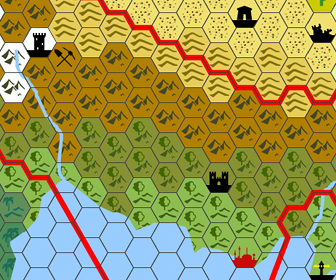As I am toying more wit the "fantasy as an alien planet" stetting idea for Savage Worlds (as first mentioned here), I find that i could use rules for hexcrawl to reinforce the theme of exploration of an unknown world. In this series of articles, I will try to adapt the hexcrawl play style to Savage Words. Let's start with some hexcrawl basics and theory...
What is Hexcrawl?
Hexcrawl is a technique for running wilderness (or wasteland, or space, or any uncharted lands) adventures. It provides rules for travel, exploration and encounters. It is usually paired with sandbox style play to create a truly open world game. In a nutshell - it adds rules to, and expands upon the "you have been travelling for 3 days" parts of RPGs.Hexcrawl is not a new idea - it existed in the beginnings of the hobby. Companies like Judges Guild, among others, produced modules for this gaming style. Hexcrawl was loosing its popularity to the ready-to-use adventure modules that, where the new hotness in the 80s and was somehow lost in the folds of time. It resurfaced recently thanks to the OSR movement. This is when I got hooked.
The idea behind hexcrawl (and the origin of its name) is that a map of the game world is expressed on a numbered, hex(agonal) grid. Each hex represents equally sized area (Savage Hexcrawl uses 6 miles hexes) of a certain terrain type and can hold many encounters. This creates a game board of sorts, that players will explore.
The GM prepares the map of the lands ahead of time. He fills it with terrain types, cities, rivers, roads, etc. Non-lazy GMs will create adventure sites and possible encounters for some, or all the hexes. Others (including myself) prefer using random tables and improvisation. Use of randomized content is often seen as a necessity in hexcrawl or sandbox gaming. The truth is, you don't have to use it if you don't want to. You can prepare adventures and encounters ahead of time and plug it in during the session. Most GMs use middle-of-the-road approach, with some prepared and some randomized content.
Players receive a corresponding, but incomplete version of the hexgrid map. Depending on the campaign, they might be given a small known area (few hexes here and there), location of a major cities or some other landmarks. Even a blank hex sheet will work (this is what I'll be using for my campaign). The players will explore the area moving from hex to hex, completing their map and encountering all kinds of people, places and adventures.
If you are thinking about running a campaign where exploration is the main focus, you should give hexcrawl a try. It can the simple "your travel for X hours" into a a whole adventure on its own and adds a"gamey" aspect to travel.
Next time we will look into how to incorporate hexcrawl into Savage Worlds, while still keeping it Fast Furious and Fun!



No comments:
Post a Comment